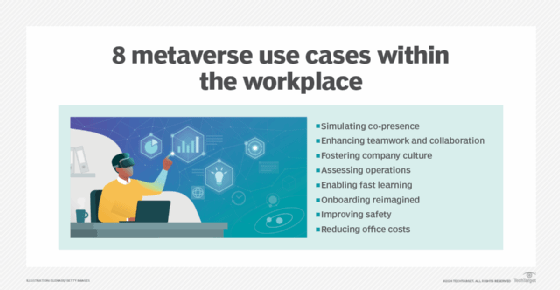Top metaverse platforms in 2026, rise of spatial computing
The metaverse is evolving, beginning with its rebranding as spatial computing and its expansion into the workplace. Here are 15 metaverse platforms to watch in 2026.
While gaming and entertainment drive the majority of metaverse platform adoption, large vendors, such as Meta and Apple, continue to invest in business use cases.
Metaverse platforms -- AKA spatial computing platforms -- are systems that let users create and interact within immersive 3D virtual environments. They generally fall into three broad categories: Consumer ecosystems, enterprise collaboration and design, and industrial spatial computing.
Consumer ecosystems, such as Roblox and Fortnite, focus primarily on entertainment. Enterprise collaboration and design platforms support business productivity and teamwork -- examples include Meta Horizon Workrooms and Apple Vision Pro. More industrial-focused platforms, such as Hexagon's HxDR, enable advanced spatial computing for engineering, manufacturing and operations.
In alphabetical order, the top metaverse platforms for 2026 are the following:
- ABB's Industrial Metaverse platform.
- Android XR.
- Apple Vision Pro.
- Dassault Systèmes' 3DEXPERIENCE platform.
- Fortnite.
- Hexagon's HxDR.
- Meta Horizon Workrooms.
- Meta Horizon Worlds.
- Microsoft Mesh.
- Nvidia Omniverse.
- Roblox.
- Schneider Electric's industrial metaverse platform.
- Siemens' Immersive Engineering industrial metaverse platform.
- Spatial.
- Virbela.
Metaverse becomes 'spatial computing'
When an emerging technology starts to mature, the terminology goes from long-winded to short, said Mike Bechtel, futurist and professor at the University of Notre Dame. This is what's happening with the technologies that constitute the metaverse. Instead of using terms such as virtual reality (VR), augmented reality (AR) and mixed reality, spatial computing is a term that effectively encapsulates what the metaverse is about, Bechtel said.
"Spatial computing is about post-screen computing interfaces that are increasingly simple and react to speech and gestures. We're going to realize in about five years how clunky and unnatural it was to log into a rectangle for everything," Bechtel said.
AI as the new UI for spatial computing
While the metaverse continues to be something of a Wild West in terms of data interoperability and integration, companies are working to improve this, Bechtel said. "Where it's all headed is … AI is going to become the new UI, and that's kind of a mind-bender."
Generative AI (GenAI) is already reshaping how people interact with and build spatial computing environments. Instead of relying on complex coding or manual 3D design, creators and users can now use voice commands or text prompts to build immersive worlds, said Karina Arteaga, CEO of Visible Global consultancy and ex-Meta Reality Labs business strategy lead. This significantly lowers the barrier to entry as it enables non-technical people to contribute to metaverse platforms.
For example, users can describe a scene or object and have AI automatically generate the 3D assets on platforms like Meta Horizon Worlds or Nvidia Omniverse. They can then adjust those assets with simple voice instructions, making the experience more intuitive.
Top metaverse platforms to know about in 2026
Based on published research studies and interviews with analysts and experts, here are the top platforms to watch in 2026. They are listed alphabetically in each category.
Consumer ecosystems
Consumer ecosystems represent the most visible and widely adopted segment of the metaverse. These platforms prioritize entertainment, gaming and social interaction.
Fortnite. Fortnite remains a dominant metaverse platform, primarily focused on gaming and entertainment. It offers immersive social experiences and virtual events that attract millions of users worldwide.
Meta Horizon Worlds. Horizon Worlds focuses on social interaction and creative expression. As Meta's flagship consumer-focused spatial computing platform, it lets users build, explore and connect in immersive virtual spaces. Unlike Horizon Workrooms, which targets enterprise collaboration, Horizon Worlds remains primarily a social and entertainment environment.
Roblox. Roblox is a popular online platform that lets users create and explore virtual worlds. Despite its massive consumer base and creative potential, Roblox has experienced significant challenges in penetrating the enterprise market. The platform faces brand incompatibility issues and has struggled to prove value to enterprises at scale, said Eric Abbruzzese, former research director at ABI Research.
Enterprise collaboration and design
Enterprise collaboration and design platforms use spatial computing to enhance workplace productivity and teamwork. These metaverse use cases have seen less enterprise adoption than industrial training use cases, said Jitesh Ubrani, research manager at IDC.
Android XR. Android XR is Google's open OS for XR devices that powers headsets like Samsung's Galaxy XR. While its roots and initial ecosystem lean into gaming and entertainment, developers built it with enterprise needs in mind. For instance, it supports enterprise security, device management and productivity applications. This dual focus positions Android XR to serve as a bridge between consumer and enterprise XR.
Apple Vision Pro. Apple's spatial computing platform Vision Pro is used primarily for enterprise use cases involving data visualization and office productivity. It is more developer-focused than the others, Abbruzzese said. It is one of the most capable extended reality (XR) platforms, he said, but adoption has not been widespread due to the device's hefty price tag. The content and development platform itself is highly capable and would have seen greater adoption and usage if there were a cheaper hardware alternative to develop for, Abbruzzese explained.
Meta Horizon Workrooms. Horizon Workrooms offers virtual collaboration spaces where enterprise teams can meet, brainstorm and work together remotely. However, the application has seen limited adoption, especially when compared to Meta's consumer channels. "I was heading the business operations and go-to-market play for Reality Labs at Meta, and by far the B2B channel was the smallest," Arteaga said.
Microsoft Mesh. Microsoft Mesh is Microsoft's spatial collaboration platform. It brings Teams-like productivity into shared 3D environments for enterprise meetings and training across PCs, VR headsets and HoloLens -- Microsoft's mixed reality headset. HoloLens can serve as one of the primary devices for accessing Mesh and has found its strongest adoption in industrial settings. As a result, Mesh straddles both enterprise collaboration and industrial spatial computing categories.
Spatial. Spatial has moved into the user-generated space after initially focusing on immersive virtual environments that facilitate enterprise collaboration, Abbruzzese said. "The platform enables users to create, customize and share 3D spaces for meetings, events and social experiences. It has a strong user base and purposefully highlights an older -- over 21 -- audience," he said.
Virbela. Virbela is one of the most enterprise-focused metaverse collaboration vendors, Abbruzzese said. It offers a metaverse-as-a-service platform which streamlines the creation of immersive 3D virtual environments tailored for meetings, events and team collaboration. The platform supports cross-platform interactivity and enables organizations to build customized virtual workplaces that enhance remote engagement and productivity, he said.

Industrial spatial computing
Dedicated enterprise platforms geared at the industrial metaverse will likely see the most usage by companies, Abbruzzese said. However, these systems typically do not go by the metaverse moniker.
ABB's Industrial Metaverse platform. ABB's platform combines robotics, AI and digital twin technology to offer immersive simulations and remote operation capabilities for sectors like manufacturing, energy and utilities. Plant operators, maintenance teams and engineers use it to conduct predictive maintenance and train staff in realistic virtual environments.
Dassault Systèmes' 3DEXPERIENCE. This platform integrates design, engineering, simulation and manufacturing processes into a unified digital environment. It enables collaborative product development with 3D modeling and supports innovation in industries such as aerospace, automotive and construction.
Hexagon's HxDR. HxDR is a digital reality platform that combines geospatial data, 3D modeling and AI to offer accurate and scalable virtual representations of physical assets and environments. The tool facilitates advanced planning, monitoring and operational decision-making in industrial and infrastructure sectors.
Nvidia Omniverse. Nvidia Omniverse occupies a middle ground between broad consumer-focused metaverse platforms such as Roblox, Fortnite and Meta Horizon, and specialized enterprise digitalization platforms designed for industrial use, Abbruzzese said. Unlike purely entertainment-driven environments, Omniverse offers advanced toolsets for 3D content creation, simulation and real-time collaboration that are tailored to industrial workflows.
Schneider Electric. Schneider Electric's industrial metaverse initiatives integrate IoT, AI and digital twin technologies to enhance energy management and automation across industrial facilities. Their spatial computing tools offer immersive visualization and real time insights for optimizing operations and ensuring safety in complex industrial environments.
Siemens' Immersive Engineering. This platform uses digital twin technology and spatial computing to create detailed, virtual models of industrial environments. These immersive simulations help engineers and operators visualize, design and optimize complex systems in manufacturing and infrastructure.

How GenAI fits into the metaverse
The past few years have given rise to mass experimentation with GenAI. Just as the web branched off into lots of individual apps for individual purposes, GenAI will also separate or fragment into dozens or even hundreds of multimodal AI agents that have fixed purposes, Bechtel said. "It will be like a little fleet of computerized concierges. I call it digital Downton Abbey -- you're going to have a staff with you everywhere you go. "
Text-based agents are already proliferating and will be used not just as an escape into a 3D virtual world, but also to bring reality itself online, he said. "We're going to start to see the evolution of text-based agents to … visual-spatial-personified agents."
While it is still early days, sooner rather than later, GenAI and agentic AI will be incorporated into almost every platform … especially for the metaverse, said Matilda Beinat, former research analyst at ABI Research. "At its core, it will be more useful for developers, creating environments, aiding in their work and as a guide in software development," she said.
Hardware advances: 'Kicked-up glasses,' AI-enhanced headsets
Thanks to AI-fueled workloads, the battery in today's headsets is dramatically better and so are the video capabilities and GPU power, according to Bechtel. He expects form factors will change from bulky headsets to glasses.
"That's where we're going to see meaningful enterprise adoption … because it's going to start to feel simpler and more elegant than carrying three, four or five rectangles around with you in the form of two phones, a tablet and a laptop," Bechtel said.
Abbruzzese also believes AI improvements will trickle down to headsets. "Applications like visual AI assistants will be scaled first on traditional hardware like smartphones and, ultimately, make [their] way to XR devices," he said.
Together, these trends point toward a near-term future in which spatial computing hardware becomes lighter, more power-efficient and increasingly AI-native -- making everyday enterprise use far more realistic.
Privacy and security in the metaverse
Right now, metaverse privacy and security carry a mix of uncertainty and inevitable regulation tightening, Abbruzzese said. "There are some default privacy carryovers from other segments into the metaverse -- age gates on social platforms being a good example -- but few metaverse-specific conversations happening today."
While big players like Meta will copy/paste privacy policies where possible, they will store the largest amount of data collection possible, he said. "Data is where the money is made currently, with few end-user-facing monetizable solutions available."
It's important to remember the metaverse is a nascent market, Beinat added. Depending on the application of the technology, there will be different priorities and different headsets adopted to ensure privacy and security are accounted for, she said.
Challenges for businesses implementing AR/VR technologies
The newness and rapid evolution of metaverse technologies present many challenges for companies. For example, interoperability between standards and platforms still leaves something to be desired.
"There is an understandable reticence to go all in on one vendor's vision of this world, out of concern that it might not operate with the eventual standard," Bechtel said.
There are also concerns about cost -- bringing in new equipment for the metaverse is a nontrivial budgetary challenge, Bechtel said. A third issue for businesses is training and user adoption.
At Paramount Global, for example, the company piloted VR in the employee onboarding process. New hires were given access to virtual spaces that enable them to tour Paramount's studio production lots to engage them in core aspects of the company's mission, Bechtel said. "It was a wonderful no-brainer for seeing how the entire joint runs," he said, "but you can imagine gearing people up with that kit and loading it up … is a longer putt than saying, 'Here, log in to this website, and take you mandatory 30 minutes of training.'"
Organizations will have to educate potential users on the value of whatever metaverse platform they select. They will need to create internal platform champions, such as product and project leads with deep knowledge of the software, to help expedite rollout, Abbruzzese said.
Will Gen Alpha engage with the metaverse at work?
Gen Alpha is the most technologically involved generation ever, Abbruzzese said, so it stands to reason they will be receptive to using the metaverse at work.
Yet, this generation also expects immediate satisfaction and a seamless digital experience, Beinat added.
"Through each platform, whether it be LinkedIn or Instagram, the younger generation is consistently watching short videos, and this instant sense of gratification is expected to influence the design of platforms, games and educational tools [in the metaverse]," she said. "They need to be intuitive, fast and engaging."
Editor's note: This piece was updated to reflect new developments in AI technology.
Esther Shein is a veteran freelance writer specializing in technology and business. A former senior writer at eWeek, she writes news, features, case studies and custom content.
Tim Murphy is site editor for Informa TechTarget's IT Strategy group.







